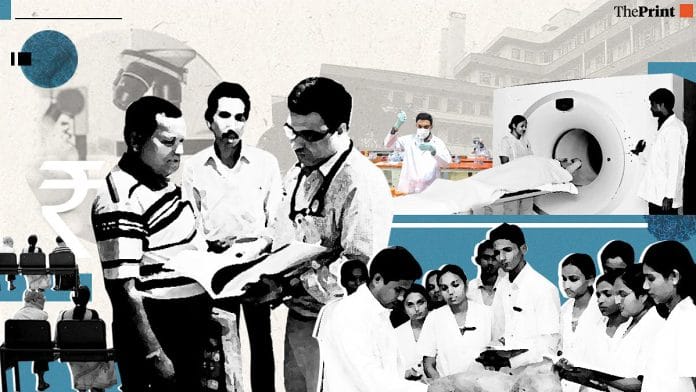New Delhi: A key announcement related to the healthcare sector in the Union Budget 2025 is the proposed establishment of cancer daycare centres in all district hospitals, 200 of which are slated to be opened in 2025-26.
The proposed centres will have 10 beds each and provide basic and essential facilities such consultation, counselling, supportive care and chemotherapy, a standard method of killing cancer cells in majority of the patients, among other facilities, ThePrint has learnt.
“The idea behind setting up the centres at district levels is to take cancer care closer to patients as this is mostly available at tertiary care centres and a large number of cancer patients discontinue or delay treatment due to travel, financial, or logistical constraints,” said a senior official in the Union Health Ministry on condition of anonymity.
“By strengthening cancer infrastructure at the grassroots level, the aim is to improve survival rates and quality of life for patients,” the official added.
The official said that according to the government plan, the proposed centres will be equipped with chemotherapy administration units, trained oncology staff, basic diagnostic tools, and telemedicine capabilities for consultations with specialists.
Additionally, the daycare cancer centres will also offer patient education and psychological support services to ensure holistic care, he said.
According to data from the Indian Council of Medical Research-National Centre for Disease Informatics and Research (ICMR-NCDIR), India records nearly 15 lakh new cancer cases annually, with malignancies of breast, lung, and oral cavity cancers being the most common.
Experts say cancer care in India is marked by huge barriers of access, lack of affordability and disparities in availability of quality care. And while significant steps have been taken for the establishment of advanced cancer centers, little has been done to extend the reach of these facilities to underserved areas.
A landmark 2023 study by researchers from multiple government institutes, including Mumbai’s Tata Memorial Hospital, found that the average direct out-of-pocket expenditure (OOPE) for cancer treatment was Rs 8,053 per outpatient consultation and Rs 39,085 per hospitalisation episode.
The study titled Financial toxicity of cancer treatment in India: towards closing the cancer care gap also estimated that per patient annual direct OOPE incurred on cancer treatment was estimated as Rs 331,177 in the country.
Given this background, the latest announcement by Finance Minister Nirmala Sitharaman has evoked positive reactions.
“Daycare cancer centres at district hospitals are much needed in the Indian scenario and can play a crucial role in making cancer care more accessible and less burdensome for patients,” said Dr Vishal Rao, group director—head and neck surgical oncology and robotic surgery, HCG Cancer Centre in Bengaluru.
By providing treatments such as chemotherapy and supportive care closer to home, said Dr Rao, these centres reduce the need for long-distance travel, thus alleviating financial and emotional stress on patients and their families.
Also read: 36 drugs to treat cancer, rare diseases exempted from basic customs duty in Union Budget 2025
New centres may save patients up to Rs 10,000 crore annually
According to an internal ministry note, seen by ThePrint, daycare centres at district hospitals could save patients up to Rs 10,000 crore annually.
“This will have huge ramification for patients in tier 2 and 3 cities and towns and rural areas,” an official in the non-communicable division of the ministry said.
Independent experts, too, agreed.
“Such centres can be immensely helpful by increasing the outreach of cancer treatment to underserved areas, especially in smaller towns, Tier 2, and Tier 3 cities,” Dr Vineet Talwar, Director, medical oncology at Delhi based Rajiv Gandhi Cancer Institute and Research Centre, told ThePrint.
Most cancer treatment is concentrated in metro and Tier 1 cities, making it difficult for the poor to access care,” he underlined.
The health ministry official quoted above said that the plan is to have a trained doctor who can administer chemotherapy, apart from nurses and paramedics to assist.
“We are in the process of finalising chemotherapy drugs that can be made available at these centres,” the official added.
Dr Talwar pointed out that for daycare chemotherapy, these facilities do not need to be large, and even smaller centres can provide this treatment.
“While services such as radiotherapy may be a challenge due to the need for specialised equipment, small surgical procedures could also be offered if trained personnel are available. Primarily, the focus should be on providing daycare chemotherapy,” he said.
Fast-growing burden
ICMR-NCDIR estimates that approximately one in nine people in India is expected to face a cancer diagnosis during their lifetime and the projected cancer burden in India is expected to rise from 26.7 million DALYs (adjusted mortality to incidence) in 2021 to 29.8 million in 2025, with the highest burden in the north and Northeast regions.
Among non-communicable diseases, cardiovascular disease contributes the most to the death rate (63.3 percent), followed by cancer (18.1 percent).
The study analysing the funding pattern of cancer treatment of India, cited above, meanwhile had revealed that diagnostics (36.4 percent) and medicines (45 percent) are major contributors of OOPE for outpatient treatment and hospitalisation, respectively.
Importantly, the overall prevalence of catastrophic healthcare expenditure (CHE) and impoverishment was higher among patients seeking outpatient treatment (80.4 percent and 67 percent, respectively) than hospitalisation.
The odds of incurring CHE was 7.4 times higher among poorer patients as compared to the rich.
The World Health Organization (WHO) defines CHE as when out-of-pocket payments are more than 40 percent of a household’s capacity to pay.
Also read: Cancer warning on liquor bottles ‘long overdue’. Even ‘light’, ‘moderate’ drinking poses threat






